Basilica of St. Josaphat
Milwaukee, WI
Buzard Pipe Organ Builders • Champaign IL
Why this organ? We decided to feature this little organ on the cover of The American Organist magazine because it is a fabulous instrument in an exquisite space, even if it is an old organ in a new location.
A vital portion of this industry’s lifeblood is the restoration and renovation of existing pipe organs, and we believe that our excellent renovation work deserves to be seen by our colleagues in this journal. We ask ourselves just as many questions before undertaking a renovation project as we do in the evolution of our new organs’ tonal style. This is essential if the renovation project is to respect the original builder’s intent, the historical nature of the instrument, and the modern musical requirements that are often placed upon a renovated organ.
John-Paul Buzard, President and Artistic Director
Buzard Pipe Organ Builders

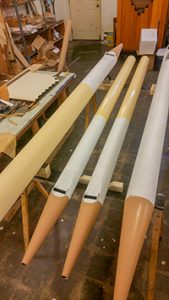
Listen to “Introduction” to the Elgar Vesper Voluntaries played on the featured organ:
Good things come to those who wait (and have the room to store interesting pipe organs until the perfect new home for them can be found)! Buzard Pipe Organ Builders, in addition to building well-crafted and highly regarded new organs, operates a busy service department that undertakes the full range of services for existing instruments. This, of course, includes the occasional “organ transplant.”
Friday, December 1, 2006, was a typical blustery day in downtown Chicago. As snow fell outside, a small intrepid band of like-minded souls gathered in the Gold Coast neighborhood to rescue the ca.1903 W.W. Kimball organ from the small preceptory of the Scottish Rite Cathedral. Because this two-manual, seven-rank tubular pneumatic instrument had to be removed on short notice before the building was to be demolished, a team of rescuers was formed, comprised of Buzard Company staff and several members of the Chicago-Midwest Chapter of the Organ Historical Society. The instrument spent several years in our storage facility that is part of our service department in Champaign, Illinois, while the search was on for the perfect new home for this instrument.
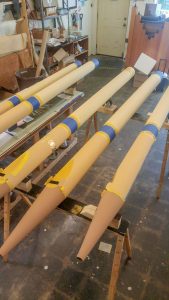

The Basilica of St. Josaphat in Milwaukee, Wisconsin, a ministry of the Conventual Franciscans, had been searching for an appropriate organ for the lower church in the crypt. The Buzard Company completely renovated the Kimball organ for this lovely and intimate space.
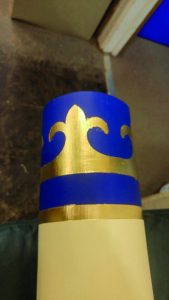
This was a stock model instrument, often referred to as a “boxcar organ,” because it left the factory in two large (and heavy) cases, shipped by rail with the pipes already installed and pinned in place. Theoretically, installation consisted of simply bolting together the two halves on site. One wonders whether there was ever a church doorway big enough for this to actually occur, or who could heft the two cases totaling 5,000 pounds into position. We certainly delivered it to the church in numerous and more manageable pieces!
The organ is described in a 1904 catalog as a “Style 17,” but in this particular instrument the organ had a tenor C-compass Oboe on the Great, but no 4′ stop as was usually the case. We replaced the Oboe with a full-compass 4′ Violina from another decommissioned Kimball boxcar organ, and the Oboe has found a home in yet a third.
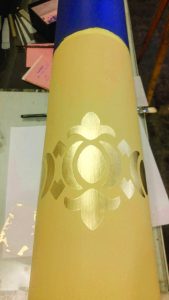
The original tubular-pneumatic primary actions were replaced with newly built electropneumatic under-actions in accordance with Kimball’s later practice. Buzard’s Opus 31-R rebuild of Kimball’s 1897–1937 organ at First Presbyterian Church in Lexington, Kentucky, provided an example of how Kimball undertook this. This decision was carefully considered, and is a good illustration of the depth of our constant questioning before undertaking restoration and renovation work. If the new owner had been a museum rather than a church, then retaining the original actions without alteration would perhaps have been appropriate. However, like many other organs of this era, these tubular-pneumatic mechanisms were not designed with future service in mind. We have provided the church with an as-new organ that is even more reliable, and can be maintained as necessary.
Some decorative elements of the casework, in particular the wood banding around the facade pipes, had suffered some losses. Working with our colleagues at Decorators Supply Company in Chicago, molds were made of the remaining existing materials and replica parts cast, which we then finished to match the rest of the case. The woodwork had originally been finished lighter, but a subsequent darker over-coating was actually a good color match to the woodwork in the Basilica’s lower church.
The keyboards, pedalboard, and all other mechanisms and pipes, including the tubular-pneumatic stop actions and Crescendo Pedal mechanism, were cleaned and restored. Wooden pipes were cleaned, stoppers were repacked, and metal pipes were repaired as necessary.
The Basilica’s rector-pastor, the Very Rev. Michael J. Glastetter, OFM Conv., was actively involved in the siting of the instrument and visual design process. We thank him and the Basilica’s director of music-organist, Christopher Berry, for their support and the opportunity to install this vintage instrument in its new home, ready for its second century of service.
The organ will have been dedicated at First Vespers for the Feast of Saint Cecilia, November 21, with music by Elgar, Guilmant, and Bonnet, as well as Gregorian chant.
Keith Williams, Service Director
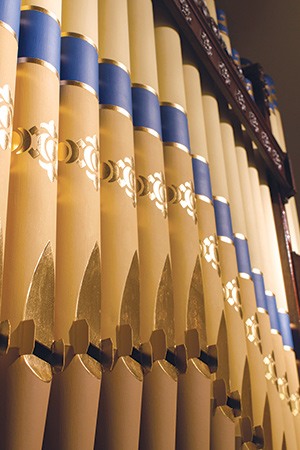
One of the most satisfying elements of this restoration has been the recreation of a vibrant, harmonious, polychrome facade decoration. Our clients were very receptive and excited about this element of the work and took an active part in consulting with us on design and color choices. These discussions resulted in a stenciled facade that simultaneously takes historical cues from earlier patterns on the pipes, and from design and color elements from within the chapel itself.
The facade pipes had been coated with two layers of paint over the top of the original treatments, and our first duty was to attempt to remove just the later layers to determine the feasibility of simply uncovering and restoring the original decoration. Unfortunately, that was not possible and we proceeded with entirely new decorations. What we did discover in removing layers was enough information about what would become our lower stencil pattern to enable a tracing to be made of it. The new upper stencil, a fleur-de-lis “crown,” draws from a very similar motif in the ceiling of the chancel, also with a deep royal blue background. With these two stencils and colors chosen, we had our facade planned.
After repairs were made to the pipes themselves, including rounding out and repair to solder seams, etc., the various layers of old paint were carefully removed with a light-duty bead-blasting setup—a messy and labor- intensive task! This was followed by a number of coats of a primer and sealer, to ensure a smooth finish.
Next, the various colors of the bodies and feet of the pipes were measured out and a number of carefully brush-painted coats applied. These areas were defined and highlighted by the application of genuine gold leaf on the mouths and banding. The bands are very carefully laid out on the pipe bodies, so to relate to neighboring pipes and their symmetrical opposites and also to be straight and square. The gold leaf was applied the traditional way, with a bright, oil-based burnishing paint applied first, followed by the leaf “size,” a varnish that becomes tacky after many hours and holds the delicate leaf firmly in place.
The stencils, one new and one old, were converted into digital files that were in turn cut into stencils by a graphics firm here in Champaign. By using custom sticky-backed, disposable stencils, we were able to very accurately duplicate the patterns on each pipe and keep very crisp edges. As with the other gilt portions, the stencil areas were prepared with multiple layers of burnishing paint and gold size. After the size is applied and before it cures, the stencil is carefully removed. When the size is ready, the three-inch square sheets of fine leaf are applied to the patterns before being carefully burnished on with a fine brush, which also trims the gold to the stencil profile.
The results of this careful, delicate, and rewarding work have been greatly admired by the Basilica community and its visitors.
David Brown, Service Foreman
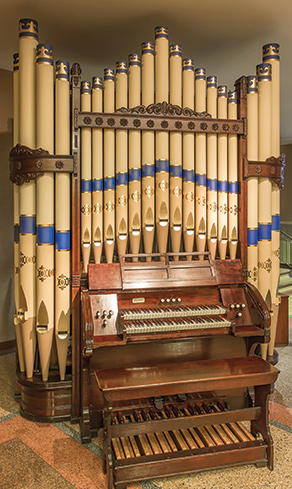



Thank you for putting this little organ on TAO December cover, and thank you for including the sound sample of it in this electronic version of the article!